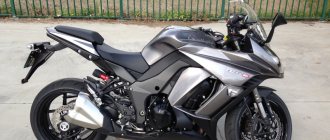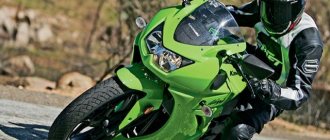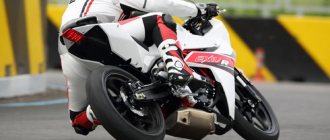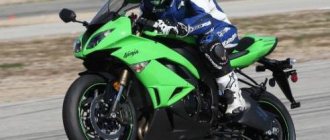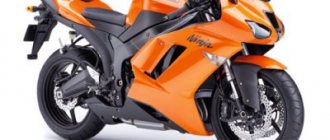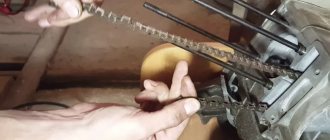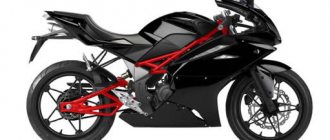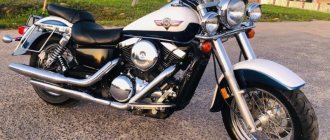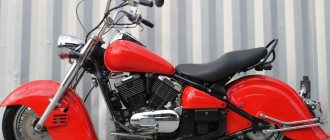- motorcycle model, Kawasaki brand,
The Kawasaki Xanthus 400 naked model appeared in 1992 and was produced until 1995. It is worth noting that this was the first factory streetfighter from Kawasaki, built on the basis of the Kawasaki ZXR 400 sports model. It is distinguished by minimal plastic, an aluminum diagonal frame, a square headlight and a slightly retuned engine (to increase traction at low and medium speeds). Unlike the ZXR 400, the Xanthus had a conventional telescopic fork.
The main feature of the Kawasaki Xanthus 400 is its liquid-cooled inline 4-cylinder engine, which produces a standard 53 hp. power and 36 Nm of torque. It differs from the ZXR 400 engine only in camshafts and visually; it also has an oil cooler. Like all sports in-line 400s, this engine is high-speed and produces maximum performance at 9000-11000 rpm.
Despite its interesting appearance and technical solutions that were ahead of its time, the Kawasaki Xanthus 400 was produced for only 3 years, after which it was replaced by the “classic” - the Kawasaki ZRX 400.
Advantages
Nevertheless, the motorcycle left a noticeable mark on history, and many similar machines now use the developments introduced in it. The bike certainly had the following advantages:
- interesting design;
- the engine was quite powerful for those times;
- maneuverability.
The motorcycle was an excellent choice for those who did not plan to use the bike for long distances. Many considered it a good solution for urban agglomerations. The maneuverability of the motorcycle is truly impressive, both at medium and high speeds.
Kawasaki turned out to be a very decent bike that could easily compete with many modern analogues. The technological solutions laid down then would have made it competitive at least until 2010.
Review of the Kawasaki Xanthus 400 (ZR400D) motorcycle
As for the device itself, its design was ahead of its time; at that time the NEOCLASSIC niche did not exist at all; let’s say, it was a pioneer. So much has been written about design, good and bad, but design really exists. And not everyone likes it, fact. But this is the highlight of the device. He makes you look around. There's no arguing with that. The frame was also a highlight for that time. In terms of application on the device, it is more similar to the classic one. Also the original design of the tidy, which is truly DEFICIT in the secondary market! As you know, when you fall, it is this part that suffers very much. And it is made in a fused body, at the same time performing the function of a windbreaker. What is undoubtedly a plus is comfort at cruising speeds of around 140 km/h. The headwind is not so overwhelming. I rode this device and... well, I put it in short. It was a long time ago. Just in 2003.
As for the driving characteristics. Yes, indeed, it was fashionable to install engines on classics, from their sports counterparts, so we know that the Super Fur has a motor from SiBiRa, On the Impulse, in my opinion, from the little Jixer. I think it’s the same story with little Phaser. Perhaps I made a mistake somewhere. If there is anything, please correct it. Cactus did not escape fashionable consideration either, having received a motor from Zakhar, and along with it his sores. It’s not that it’s completely bad (I’m talking about the engine), but difficult-to-maintain carburetors and an incomprehensible gearbox with a second gear that is always not plugged in and out of gear have migrated in full (so to speak) in full. Overall the device is very reliable. It couldn’t be otherwise! In fierce competition, not a single manufacturer could afford to produce a product of lower quality than its competitors (by the way, this is written in the magazine, and one cannot disagree with this).
But in general, the device has a direct landing and a straight steering wheel. It steers... well, how else can a 400, with an aluminum diagonal frame and a short wheelbase, steer? Fine. Although the mot is peculiar. He was way ahead of his time. And it didn't sell very well in Japan. And it was made for the domestic market. Try it, then try it, but it’s difficult to find a good device in Japan. There are simply few of them. And what we have is not trash, of course, but it’s not first or even third freshness either. It will soon become like a Honda Magna. A legend desired by many. But so rare. I would oppose Hornet to him, but...
For its time, the motorcycle was simply revolutionary. The characteristics of the motorcycle are impressive: the engine is from the super sporty ZX4R Ninja, with a power of 53 hp (without afterburner), the brakes are from the ZX9R, the frame is of the spinal monocurrent type (the ZXR has a duplex frame), almost no plastic, dry weight is only 168 kg, with all this a classic fit and a completely flexible disposition. This motorcycle can be said to have opened the Naked or Streetfighter category at one time. The motorcycle is definitely evil both in terms of characteristics and ride quality. In terms of maximum speed, perhaps only the Yamaha FZR400 and Honda VFR400 can compare with it, and even then it all depends on the pilots - all the other motorcycles (in this class) are just nervously smoking in the corner. But Kawasaki is very different from its closest competitors, it is not a pure track Honda with its monstrous uncomfortable landing, or an inadequate Yamaha with its completely unpredictable acceleration curve. YES it is not as sharp as its competitors, one person even managed to say that this is a women’s motorcycle, but is it necessary to be so sharp? in traffic jams it behaves completely adequately and predictably - you need to fry the gas - it will fry, you need to stand in stoppies or sharply change lanes - for God's sake, as much as you like, you want a wheelie or a knee turn - spit it out, with no yaw jerks or wobbles. In general, here it is a masterpiece of that time...
I fell in love with the Xanthus at first sight, taut, with a diagonal aluminum frame, a huge square headlight with two reflectors, a fighter's raised tail and a dual muffler on the right, it became for me the personification of an angry city motorcycle. This geometry, combined with large brake discs, a low steering angle and a monoshock, should have made its handling sharp and predictable. The engine was borrowed from the ZXR400, which was supplied to Europe, so there should not have been any special difficulties in finding spare parts for the engine. The engine was derated to 53 hp, the crankcase was replaced with a larger capacity, but the oil cooler was removed, and the radiator was significantly reduced. The engine runs quite noisily, with a slight clicking sound, but you won’t be able to hear the fault. I also appreciated the lack of plastic as a plus for a beginner.
So, the purchase took place. I got a car manufactured in 1996, which had been in Moscow for one year and had 15,000 km on the odometer (they’re lying, of course). I won’t describe how I learned to ride, I’ll just leave my impressions of the motorcycle (at the time of writing this article, I had ridden about 7 thousand km on the Xanthus, 4 thousand on the ZZR 600, and a little on some other Japanese ones).
The riding position on the motorcycle is classic; for me, with a height of 180 and a weight of 95 kg, it was quite comfortable (I note that on my motorcycle, instead of a standard handlebar, there were halves and clip-ons, so the landing was somewhat more sporty). The hips fit comfortably into the recesses on the tank. The rear seat is small, but allows you to carry passengers, but the seating position for them cannot be called comfortable; the footrests are a bit high. The motorcycle is equipped with a healthy square headlight with two round reflectors inside; both lamps burn at the same time and do not produce a weak light beam (compared to its “one-eyed” counterparts). The instrument panel is equipped with a tachometer, speedometer, neutral indicator, fuel level, engine temperature, oil pressure, turn signal and high beam indicators. In general, the readings are easy to read even in bright daylight.
In order to increase the stiffness of the suspension, the rear monoshock absorber was tightened almost all the way, one notch remained, and fork oil with a viscosity index of 15 was poured into the fork.
The motorcycle pleases with its controllability, shows absolutely no tendency to bend the fork (see zizer, bandit), the rigid frame and pendulum allow you to lower the motorcycle to the pegs and take turns at a good speed, while the motorcycle does not wag its tail like a happy dog. I consider 140 km/h to be a comfortable speed for a motorcycle; up to 160 the motorcycle picks up quite quickly for a 400, but the remaining 20 doesn’t pick up very readily, and you have to bend down and get blown away. Frequent trips to the karting track in Mytishchi strengthened my confidence - the motorcycle has one of the best suspensions and geometry in the class, holds the road perfectly and allows you to confidently take numerous turns.
The engine runs quite smoothly, good traction starts around 6 thousand rpm, and increases almost without changes (slight pick-up around 11 thousand) to the red zone.
The brakes of the Kawasaki Xanthus are quite adequate to its weight and dynamic characteristics. With skill, you can easily put the motorcycle in stops (this is easier on a bandit), but if possible, I would change the original two-piston calipers to four-piston ones without hesitation. Ideally, I would like to replace the traverses with the fork; in my opinion, they are not rigid enough, but in the neoclassical class they are definitely enough (by the way, the fork on the Xanthus is the same as on the CB400SF).
The disadvantages include a relatively weak timing mechanism (the chain, rollers and tensioner must be replaced after 30-40 thousand km, i.e. they almost always come to Russia with an exhausted timing life) and a heavy exhaust system that is susceptible to corrosion.
As a result, I have very favorable memories from Xanthus, exemplary handling, light weight and responsive engine. A very balanced device for the city and small forays, which was in many ways ahead of its time. The motorcycle is quite reliable, like most Japanese ones, during its operation there was not a single breakdown.
Engine
This car has a four-stroke, four-cylinder engine. It is in-line by type. Its working volume is 398 cubic centimeters. Cooling is liquid. At 9,500 rpm, peak torque is 36 Newton-meters. At 11,500 rpm, peak power is 53 horsepower.
Thanks to this engine, the motorcycle can accelerate to 100 kilometers per hour in less than 5 seconds. At that time it was very good! The maximum speed of the bike was quite high - 180 kilometers per hour.
012_moto_0211_040
(+) Having sliders on a motorcycle is not just desirable, but vital. When a motorcycle falls, it is not only the plastic that suffers (even used ones are not cheap at all), but also the engine covers, which for this reason are in serious short supply even at large engine dismantling sites.
WHAT TO FOLLOW? The main thing is not to forget that the Zizer is not a sportbike. Do not try to set speed and acceleration records with it. The key to a long life of the engine and gearbox is smoothness and softness. A rather heavy machine with a phlegmatic engine is indeed not as playful as similar motorcycles from other companies, but the Zizer’s purpose is completely different than, for example, the no less popular Honda CB400SF. The ZZ-R is a car for traveling, that is, for smooth and uniform movement over long distances, and not a city “bullet gun”. You need to remember this constantly.
It is best to fill the engine with high-quality “synthetics”, monitor its level and change it at least once every 7-8 thousand kilometers. The model is not oil-guzzling, but a new device may well “eat up” the lubricant, and the sensitivity of the engine to its quantity has already been mentioned above.
WHAT TO BUY? If your motorcycle is not equipped with sliders, you should install them as soon as possible. The protection of the motorcycle in case of falls is very low. This is perhaps the only important recommendation. Otherwise, the depth and focus of tuning is determined only by the tastes and thickness of the owner’s wallet. Since the ZZ-R400 is completely similar to the 600 cc “European” in terms of dimensions and seats, you can find a lot of tuning for it, ranging from pannier systems and touring glasses to “gel” seats and other baubles of varying degrees of usefulness.
Estimated cost of spare parts for Kawasaki ZZ-R400
| Name | Original spare parts, rub. | Non-original spare parts, rub. |
| Repair kit for 2nd gear (gear, track shaft, fork, pan gasket) | 11500 | — |
| Clutch release shaft | 1500 | 1000 (used) |
| Voltage regulator relay | 6800 | 2000 (Chinese noname) |
| Front plastic (muzzle) | 26500 | 6000 (used) |
| Engine cover left. + gasket | 3900 | 1800 |
| Engine cover right + gasket | 6300 | 4000 |
| Sliders | — | 2600 (Crazy Iron) |
Spare parts, mostly available in stock.
Spare parts are sometimes in stock.
Spare parts, mainly imported to order.
COMPETITORS.
Dimensions and weight
The length of the motorcycle is average - 2030 millimeters. Its height is 1070 millimeters. Width – 745 millimeters. The saddle height reaches 775 millimeters. The curb weight of the bike is 186 kilograms, and the gas tank capacity is 14 liters. The wheelbase size is 1380 millimeters.
Chassis and brakes
The motorcycle frame is diagonal, made of aluminum. It perfectly reflects the character and type of motorcycle. The characteristic outlines are easy to recognize even in a motorcycle parking lot. This road predator will not get lost among other two-wheeled vehicles.
The rear suspension of the car is pendulum, with a monoshock absorber. The front suspension is made in the form of a telescopic fork. The rear brakes are a single disc with a diameter of 220 millimeters, accompanied by a single-piston caliper. Front brakes - two discs, each with a diameter of 310 millimeters; they are equipped with four-piston calipers.
The motorcycle has a very comfortable steering wheel and stylish alloy wheels, which makes it very close to a real sports bike. In fact, it's almost a sports car.
011_moto_0211_040
The speedometer “up to 260” indicates that the device is “not original”.
The speedometer “up to 260” indicates that the device is “not original”.
So, the device from 2000–2004, just imported from Japan, can be considered optimal in terms of price-quality ratio. It will cost an average of 130–170 thousand rubles. There is no point in buying newer devices from an economic point of view: for 200 thousand rubles. you can choose a much more cubic capacity apparatus.
Considering that, as a rule, “four hundred” cars do not stay in the same hands for more than a couple of seasons, we can safely talk about the high liquidity of this type of equipment. There is always a demand for entry-level motorcycles among the “younger generation”, and regardless of the condition of the motorcycle, it will be easy to sell it, although the amount that can be earned for a “running” device will directly depend on its condition. If during a year or two of operation the ZZ-R rarely encountered asphalt, did not participate in “street racing” and was well maintained, it will lose no more than 15–20% in price. When selling, however, it is worth considering that in recent years, entry-level equipment has shown a noticeable tendency to outflow to the regions. So, perhaps, it will be much easier to sell the “zizer” if you place advertisements in regional information resources on an equal basis with the central ones.
WHAT TO WATCH?
(-) A “crunchy” second gear while driving or a “jumping out” second gear is not a “family disease”, but a consequence of an overly zealous driving style in a vehicle that is calm in nature and purpose. Second gear is the heaviest gear on any motorcycle, as the difference between the gear ratios of first and second is greater than between any other adjacent gears, and the first-second pair is used most often, especially in urban traffic. Due to the difference in gear ratios and, as a consequence, the difference in the rotation speeds of the primary and secondary shafts, the second one is engaged with a noticeable shock load on the fork, the drive shaft and the gears themselves, which is why it becomes unusable after 40–50 thousand kilometers. All motorcycles are susceptible to this “disease”, especially “400” ones; it’s just that in the “Zizer” the unit itself has a slightly smaller margin of safety, which is why it fails faster than, for example, in a Honda.
The malfunction is diagnosed either on the move or while standing still - while holding the brake on the motorcycle, you need to engage second gear and smoothly release the clutch. If the motorcycle stalls, most likely everything is in order with the gearbox, otherwise the gear will simply “jump” into neutral. Overhauling the gearbox along with spare parts will cost approximately 25–30 thousand rubles, and, in addition, is a signal that the motorcycle is “tired” and other components. In short, if you suspect a gearbox malfunction, you should refuse to purchase this copy.
(-) It is worth paying attention to the engine oil level , especially if the motorcycle is bought second-hand. Even short driving with insufficient oil level can “kill” the crankshaft. By the way, the general increased noise of the engine itself indicates that, most likely, it was not “fed” with the best oil, did not monitor its level and was not changed in a timely manner. So it’s better to refuse a “clattering” motorcycle, even if the plastic is in perfect condition and the engine runs smoothly. What “surprise” the motorcycle will present after purchase is unknown.
(-) The tight movement of the clutch lever indicates that the release cam located on the shaft shank has worn out. The part itself is inexpensive (see Parts Table), but you need to remember that to replace it you need to remove the engine cover, so you will have to order a new cover gasket with the new shaft.
(-) Unstable engine idle can be caused by several reasons. Overheating often warps the plastic of the air filter housing, most often on the right side, and a gap forms in it through which unpurified air enters the engine. As a result, there is a violation of mixture formation and rapid contamination of carburetors. To detect this defect, just look into the gap between the gas tank and the diagonal of the frame. If there is a gap in the airbox, it will most likely be visible. The malfunction can be easily fixed using sealant or even regular tape. Also, the “fistula” may be located at the joints of the airbox and the air ducts leading to the carburetors.

